December 14, 2007
Air Date: December 14, 2007
FULL SHOW
SEGMENTS
Bali Climate Talks Wrap Up
/ Steve CurwoodView the page for this story
The international community struggles to come up with a plan for the next phase of the Kyoto Protocol, and Al Gore asks nations to move forward rapidly to fight climate change, despite the United States’ reluctance to call for mandatory action. Host Steve Curwood reports on the progress and conflicts as the United Nations climate conference wraps up in Bali,including developments regarding a tropical forest protection plan known as REDD- Reducing Emissions from Deforestation and Forest Degradation. (12:00)
Kucinich on Climate Change
View the page for this story
If he were president, what would Dennis Kucinich do to combat climate change? Living on Earth host Steve Curwood moderated the first-ever presidential candidates' forum on global warming, where Representative Kucinich answered just that question. Tune in for the third and final installment of our forum coverage which highlights one of the most serious issues the next commander-in-chief will face. (18:00)
Java Trees
View the page for this story
While Indonesia planted millions of trees to absorb the greenhouse gases caused by the Bali climate conference, the nation’s record on tree conservation has been dismal, especially on the island of Java. Java used to be home to one of the world’s oldest teak forests. But illegal logging, fires, and government mis-management have destroyed the trees. We have a report from Deutsche Welle Radio and Java’s Radio Bass (BASE) FM. (08:25)
Eco-Christmas Trees
/ Alexandra GutierrezView the page for this story
On Matt Haas' organic farm in Biddeford, Maine, the trees are both figuratively and literally green. Living on Earth’s Alexandra Gutierrez takes a walk with Haas to find the perfect, eco-friendly Christmas tree. (03:30)
A Wild Xmas
View the page for this story
Snapping shrimp, a mountain gorilla, dolphins and frogs: these are just some of the animal voices used in the album “A Wild Christmas.” Sound engineer Bernie Krause dipped into his enormous archive of sounds from the wild and orchestrated them into a compilation of holiday tunes. Special guest solo by Molly the parrot! (04:30)
This week's EarthEar selection
listen /
download
Dancers on Tanjoe beach in Bali perform to a gamelan orchestra.
Show Credits and Funders
Show Transcript
HOST: Steve Curwood
GUEST: Bernie Krause, David Kucinich, Alden Meyer
REPORTERS: Alexandra Gutierrez, Michael Lawton
[THEME]
CURWOOD: From Public Radio International—this is Living on Earth.
[THEME]
CURWOOD: I’m Steve Curwood. Here in Bali, Indonesia, the United Nations Climate Change Conference has a new consensus agreement that puts major developing countries on a path of constraining emissions. Luminaries including Al Gore addressed the gathering:
GORE: The earth—because of all this extra CO2—now has a fever. And the fever is rising. The experts have told us that it is not an affliction that will go away and heal itself. It requires intervention. If your child has a fever and the doctor says that this is not a virus that is going to be gone tomorrow—‘you need medical intervention.’ And if you get four opinions and they all say the same thing, you act. That is the situation that we face today.
CURWOOD: The UN climate conference in Bali, and more this week on Living on Earth.
[THEME]
ANNOUNCER: Support for Living on Earth comes from the National Science Foundation and Stonyfield Farm.
[THEME]
Bali Climate Talks Wrap Up
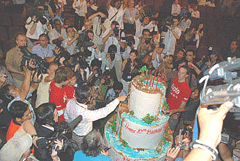
Japanese Environment Minister Ichiro Kamoshita cuts the 10th anniversary cake of the Kyoto Protocol. (Courtesy of Earth Negotiations Bulletin (ENB))
CURWOOD: From Nusa Dua, on Bali Island in Indonesia, this is Living on Earth. I’m Steve Curwood reporting from United Nations Climate change conference here.
[DRUMS PLAY AND PEOPLE SINGING]
CURWOOD: Island children greeted delegates from almost every country in the world as hundreds of reporters, scientists and campaigners descended on this South Seas resort island for the first two weeks of December.
Some shouted, some pleaded, some simply quietly negotiated about how the world should move forward after the first so-called commitment period of the Kyoto Protocol expires in 2012. The mission was to develop a plan for how to move forward in the fight again global warming, with 2009 as the target for a final agreement.
While the negotiators were vague about the precise amount of greenhouse gas reductions to be negotiated in the years ahead, there were breakthroughs in terms of developing countries and forests. With me now to explain those and other issues is Alden Meyer of the Union of Concerned Scientists.
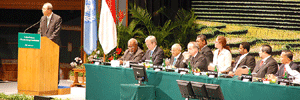
United Nations Secretary-General Ban Ki-moon addressing delegates at the opening of the High-Level segment. (Courtesy of Earth Negotiations Bulletin (ENB))
But they are willing to put significant proposals on the table to slow the growth and eventually cap and reduce their absolute emissions of greenhouse gases over coming decades. And that’s a real political breakthrough. It’s the kind of thing that people in the United States, who have been critical of the Kyoto Protocol, have said it’s not global and it won’t work because China and India and Brazil won’t do anything. Well, they’re willing to do some very significant things in negotiations over the next two years.
CURWOOD: What are the kinds of numbers that the developing countries say they’re willing to take on as part of the whole, that is, as part of the whole world?
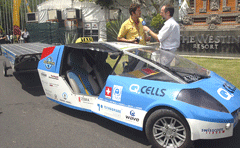
Five months after a pioneering world tour from Switzerland to Bali, a solar powered taxi has arrived at the UN Climate Change Conference.
(Courtesy of Earth Negotiations Bulletin (ENB))

Japanese Environment Minister Ichiro Kamoshita cuts the 10th anniversary cake of the Kyoto Protocol.(Courtesy of Earth Negotiations Bulletin (ENB))
CURWOOD: I understand there was a breakthrough in terms of tropical forests. What happened?
MEYER: Well, what happened is that for the first time countries formally agreed to put on the negotiating table proposals to help developing countries with rainforests—Indonesia or Brazil, Congo, some of the Central American countries, others—help them get the money and technical assistance they need to preserve their rainforests rather than feeling like they have to cut them down.
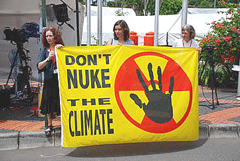
Climate protesters getting their message across.(Courtesy of Earth Negotiations Bulletin (ENB))
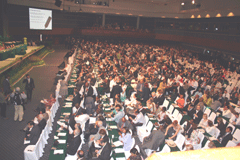
The delegates gather at the UN Climate Change Conference (Photo: Steve Curwood)
MEYER: By the meeting in Copenhagen at the end of 2009, they hope to have wrapped up negotiations on this next phase of the international climate treaty process. Fortunately, that’s about ten months after the next president takes office. There’s been a lot of talk in these halls about how willing he or she may be to engage more constructively in this debate than President Bush has been. And people are putting a lot of stock in the representation of U.S. and environmental and business groups here, that the next president will be more forthcoming and willing to step up to the plate and provide U.S. leadership again in this process.
CURWOOD: How satisfied are you with what happened here in Bali? From your perspective, did the world get enough to go forward?
MEYER: Well, it obviously isn’t a perfect result, but it’s not a disaster. It could well have been a disaster. It could have come crashing down. We could have seen a polarization between North and South that could have set back the process. We didn’t get the outcome that we wanted with clear targets for going forward over the next two years, but we got enough there I think to continue to build political will in the united states, to have the rest of the world going forward without us for the next year, and then to let the next president of the U.S. reengage in early 2009 and hopefully produce a strong, new agreement—negotiated agreement by the Copenhagen meeting by the end of that year.
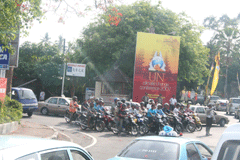
A billboard announcing the UN conference is a back-drop to the morning commute. (Photo: Steve Curwood)
MEYER: Good to be with you, Steve.
CURWOOD: At a moment when it seemed that negotiations had become hopelessly bogged down here in Bali, former Vice President Al Gore was perhaps the most prominent of the dignitaries who came here to encourage the negotiators. The former vice president came from his Nobel Peace Prize ceremony in Oslo to address the climate change conference. He chastised the Bush administration for being what he called an obstacle and urged the delegates to consider the long term. Here’s an excerpt of his remarks.
GORE: We the human species face a planetary emergency. Just this week new evidence has been presented. I remember years ago listening to the scientists, who specialize in the study of ice and snow, express concern that sometime toward the end of the 21st century we might even face the possibility of losing the entire north polar ice cap. I remember only three years ago, when they revised their estimates to say it could happen halfway through the 21st century, by 2050. I remember at the beginning of this year, when I was shocked, along with others, to hear them say it could happen in as little as 34 years. And now, this week, they tell us it could completely disappear in as little as five to seven years.
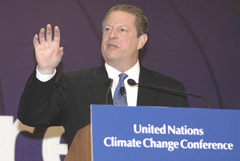
Nobel Peace Prize laureate Al Gore speaks at a side event organized by the Alliance for Climate Protection (Courtesy of Earth Negotiations Bulletin (ENB))
[APPLAUSE]
GORE: Decades ago Martin Luther King Jr. said, ‘injustice anywhere is a threat to justice everywhere.’ In like fashion, global warming pollution increased anywhere threatens the future of world civilization everywhere. That is the basis for rethinking what used to be called ‘foreign aid,’ or assistance. We have an obligation to form partnerships to reduce CO2 everywhere on Earth. So we must leave here with a strong mandate.
The greatest opportunity inherent in this climate crisis is not only to quickly deploy the new technologies that will facilitate sustainable development and create the new jobs and to lift standards of living. The greatest opportunity is that in rising to meet the climate crisis, we in our generation will find the moral authority and capacity for long-term vision to get our act together in this world. We are one people, on one planet. We have one future, one destiny. We must pursue it together and we can.
When we hear of that phrase ‘capacity building,’ it’s usually used by someone in a wealthy country talking about poor countries. I think it’s time we had capacity building in the wealthy, developed countries. For leadership, and for partnership, and for cooperation, and for vision.
[APPLAUSE]
GORE: Instead of shaking our heads at the difficulty of this task and saying ‘woe is us, this is impossible, how can we do this? We’re so mad at the ones that are making it harder.’ We ought to feel a sense of joy that we have work that is worth doing that is so important to the future of all humankind. We ought to feel a sense of exhilaration that we are the people alive at a moment in history when we can make all the difference. That’s who you are. You have everything you need. We have everything we need, save perhaps political will. But political will is a renewable resource. Thank you very much.
[APPLAUSE AND CHEERS]
CURWOOD: Former Vice President Al Gore, speaking at the United Nations Climate conference here in Bali on Dec 13.
[PEOPLE TALKING IN AN INDONESIAN LANGUAGE AND LAUGHING]
CURWOOD: In the final hours of the meeting, the environment minister of Indonesia gathered on a beach next to the convention with buckets of water. In the buckets were hundreds of baby turtles. People were invited to release into the sea.
As these baby turtles slowly crossed the sand and slid into the sea, they joined a reproductive ritual that has been going on for more than 260 million years. And as the turtles crawled, perhaps it was a metaphor for the negotiators to consider that the slow and steady usually wins the race for long-term survival.
[INDONESIAN FLUTE PLAYS]
CURWOOD: Throughout the negotiations in Bali, many speakers spoke directly or indirectly about the American presidential elections—citing 2009 as the time to set in stone the next global warming gas limits under the Kyoto Protocol. So today we continue our series on how US presidential candidates say they plan to fight climate change. Representative Dennis Kucinich took part in the Los Angeles presidential forum on global warming—his views right ahead. Keep listening to Living on Earth.
Related link:
United Nations Framework Convention on Climate Change- Bali, 3 - 14 December 2007
Kucinich on Climate Change
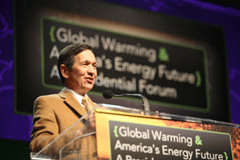
Rep. Dennis Kucinich at the Presidential Forum on Global Warming and America's Energy Future. (Photo: Laura Kleinhenz)
CURWOOD: It’s Living on Earth. I’m Steve Curwood in Bali, Indonesia, at the United Nations Climate change conference. Many speakers during these negotiations have mentioned the U.S. presidential race in some fashion. And with good reason: the next phase of Kyoto will have its final negotiation rounds in 2009, after President Bush has left office. The Bush administration and the government of Turkey are the last holdouts among the developed nations to still be saying ‘no’ to Kyoto. Australia reversed its opposition and began ratification a few weeks ago, after a new prime minister took office. So, what will the next U.S. president do about Kyoto and the whole threat of global warming?
In November I moderated the first-ever presidential forum on global warming. The event in Los Angeles allowed the presidential candidates to explain how they would respond to the challenge of global warming if they made it to the White House. The Republican and Democratic candidates were all invited. Only three—all Democrats—showed up: Senators Hilary Clinton and John Edwards, and Representative Dennis Kucinich. Each of the candidates gave an opening statement, then faced questions from a panel—Mary Nichols, chair of the California Air Resources Board, David Roberts of the online magazine Grist, and me. Today we have excerpts from Representative Dennis Kucinich.
[APPLAUSE]
KUCINICH: Thank you very much. It’s great to be at a presidential forum that’s not sponsored by the coal industry. I just want to say that from the beginning—
[APPLAUSE AND CHEERS]
KUCINICH: As the last one was. But, I want to speak to you today about a vision of the America that can be. It’s a vision that’s held close by so many of us. But it’s seldom articulated from a presidential forum. Let me tell you what I will bring to the presidency – an environmental consciousness that is demonstrated by the choices that I make in my own life. Little home in Cleveland, Ohio, 1600 square feet. A small Ford Focus that gets about you know, 30 some miles to a gallon. A vegan diet that is compassionate and mindful and respectful of the environment. See, if you want a leader who can reach out and lift this planet up, then we have to look at—how do you live? Because you can talk the talk, but do you walk the walk? And so, as I speak to you today, I want to demonstrate to you an awareness and an ability to be able to lead this country forward to a new era of environmental sustainability and environmental consciousness.

Dennis Kucinich (Photo: Laura Kleinhenz)
It starts with an understanding of the world as one. I see the world as being an integrated whole. I understand the world as being interconnected and interdependent. And that the choices each one of us makes affects all of us. As any one of us chooses, so chooses the world. And when you come from that understanding you know the great responsibility that each one of us has, individually. And responsibility that we have collectively as Americans to try to engage in what Thomas Barry called ‘the great work of our lives,’ to repair our relationship with nature and to repair the planet.
Now how would I do that as president? First, we must participate fully in the biological weapons convention, the chemical weapons convention, the small arms treaty, the landmine treaty, join the international criminal court and participate in the next round of climate change talks with a real intention of reducing greenhouse gas and carbon emissions. This is what the United States must do, and this is what a Kucinich presidency will be about. It’s a call to conscience. And it’s also a call for a new vision of what’s possible in America. That’s what I want to share with you in the next six minutes. And that is what I call the ‘works green administration.’ It’s infusing environmental consciousness into every aspect of government and all aspects of our social and economic and political affairs in this country.
And here’s how it would work: it begins with the intention of having every department of the federal government be involved in sustainability and in green consciousness. Let’s go down the list: transportation. Under a Kucinich Administration, massive spending for rebuilding the transportation infrastructure for mass transit so that we can make mass transit available all over America—
[APPLAUSE]
KUCINICH: --in housing, in Senate for building green housing and having the environmental consciousness of our entire building programs be involved in looking at energy-efficient homes, and homes that use natural lighting, in homes that are not using materials that are inherently dangerous. The Department of Energy would provide disincentives for the use of oil, coal and nuclear, and incentivize the creation of wind and solar microtechnologies so that we could create millions of jobs applying those microtechnologies to homes and businesses across this country, dramatically reducing our carbon footprint, moving the economy, government as an engine of sustainability, priming the pump of the economy, lowering energy costs, insulating millions of homes. I mean, we can do this. We have the ability to do it. We need the leadership to do this. And the Department of Education—we would teach our children environmental principles from the earliest age so they could integrate that into the way they live.
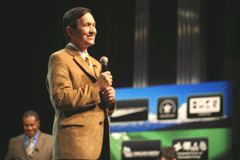
Representative Dennis Kucinich at the Presidential Forum on Global Warming and America's Energy Future. (Photo: Laura Kleinhenz)
[APPLAUSE]
KUCINICH: In the Department of Commerce, all of our trade agreements would be based on environmental quality principles and we would start by canceling NAFTA and creating environmental principles in all of our trade agreements to protect the water and the air and the land.
[CHEERS AND APPLAUSE]
KUCINICH: In the Department of Interior—removing all of these incentives that exist for the extraction of our natural resources. America must stop the exploitation of the land, and protect our Native Americans whose land is being poisoned by uranium mining and other types of mining. We need a president who can take that stand.
[APPLAUSE]
KUCINICH: Those who say that we have to sacrifice into the future, I think that’s misplaced. I think there’s an unlimited amount of wealth out there that’s waiting to be called forward by our creative genius if only we will go green. And so—
[APPLAUSE]
KUCINICH: John F. Kennedy called forth the American people to participate in something that was bigger than all of us. Kennedy said that, ‘let the word go forth at this time and place that the torch has been passed to a new generation.’ We are the generation that we’ve been waiting for, and we just need to move forward with courage and with compassion and with vision to create the world that we want. Thank you very much.
[APPLAUSE AND CHEERS]
KUCINICH: Thank you. Works green administration. Thank you.
CURWOOD: Thank you, Congressman. So join us for a conversation here. You’ve laid out a very ambitious program that I think a lot of folks here seem to like.
[LAUGHTER]
CURWOOD: The question is—you wake up one day in January of 2009, there you are at 1600 Pennsylvania Avenue—how do you do this? People have been talking about this for years and it hasn’t happened. How could you make that difference?
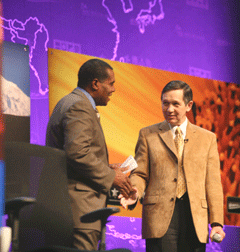
Steve Curwoood and Dennis Kucinich. (Photo: Laura Kleinhenz)
KUCINICH: Well it begins with a president who has the awareness of where the hearts of the American people are. People are ready to go in a new direction. If you have a president who’s really ready to bring about transformation, then you move forward courageously and go to the country, take it to the people. They discovered, by the way, yesterday, a picture of Lincoln at Gettysburg, I’m told. We need to rediscover the principles of that speech at Gettysburg about a government of the people, by the people, and for the people. And elect a president who’s not tied to these interest groups in any way, shape or manner. I mean, I’m ready, Steven. I’m ready today.
[CHEERS AND APPLAUSE]
KUCINICH: Thanks for the chair, but I’m not a chair guy.
[LAUGHTER]
NICHOLS: Let me follow up a little bit on that question because your vision and the way you present it with passion are getting us all excited. And then we remember that we had a vice president once who wrote a book about global climate change and an administration that went to Kyoto and negotiated a treaty and then wasn’t even able to present it to Congress because they were told it was dead on arrival. It couldn’t possibly be acted upon. And the politics in the Senate don’t seem to have changed all that much based on what we’re seeing right now. So, you know, here you are, you come into office with a mandate, but what are you going to do to reverse the dynamics that seem to be mired down in the Congress?
KUCINICH: I mean, you’re absolutely right, there’s tremendous resistance built into the political system. I would have no, no hesitation whatsoever to go over the heads of Congress right to the American people. If we have to free our Congress from these interest groups, I’m the one who will lead the way to do it without any hesitation whatsoever. If you’re ready for that kind of a president, I’m ready for you.
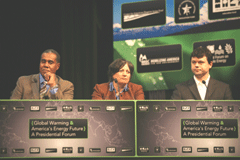
(L-R) Moderator Steve Curwood and panelists Mary Nichols (California Air Resources Board Chair) and David Roberts (Grist.org.) (Photo: Laura Kleinhenz)
[APPLAUSE]
ROBERTS: All right Mr. Kucinich. I think we can acknowledge that not everyone who supports your agenda lives in a large city on the West Coast. But at the same time, not everyone who opposes it lives in the Beltway. There are people who legitimately fear losing jobs, who legitimately fear having their energy prices raised—labor unions, coal miners. There are real people out there who fear the kind of thing you’re talking about. What do you say to them in particular other than—‘50 years from now, we’ll have a better country.’ What do you tell them?
KUCINICH: Well you have to understand the interrelationship between all the economic factors in our economy in order to take a stand for sustainability. Leadership can look at a ‘works green administration’ in producing jobs and creating environmental progress and economic progress that we haven’t see. Let’s talk about mining, for example. I understand coal miners are very concerned about their jobs. Here’s what I’m willing to do: go to the coal miners and tell them, ‘look, we’re going to make sure that you have a pension, that you can have the money to feed your family, and you don’t have to worry about that, because this is the work you chose to do and you did it, and it was important to the country at a point, but now we have to make a transition.’ Now it’s true, there are people who are going to be resistant who aren’t in Washington, and I’m aware of that. But the resistance that you find is generally from the interest groups who are trying to keep, you know, want to keep mining coal, who want to build new coal facilities, who want to build new nuclear plants with all the waste that’s attendant, who want to keep us in oil and fight wars to get it. Those are the interest groups who right now control our government. But under a Kucinich Administration, their control is broken. And if the Congress wants to stand by those interests, we go to the American people, and then we return to a government that the people really control. So I understand what you’re saying. But I’m also ready to take a stand. The question is, are you going to have somebody in the White House who can take a stand, who’s capable of doing it.
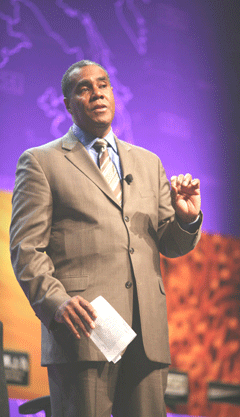
Steve Curwood moderated the forum. (Photo: Laura Kleinhenz)
KUCINICH: Well not just a pension—you’d have a guaranteed income. This is another thing I want to talk about in terms of changing monetary policy, because we really have to look at our monetary policy and how that relates to the environmental choices that are made in environmental policy. I’m speaking of a guaranteed annual income.
CURWOOD: For everybody?
KUCINICH: Yes, absolutely. I want to see such tremendous economic progress in this country that we can not only have a guaranteed income but also a national dividend so that everyone can share in the great economic progress of America. The only thing that limits us is our thinking.
CURWOOD: But let’s come down to the practical implementation of what you’re talking about here. You’re form the state of Ohio. There are a lot of coal miners in Ohio. And as president, you’re going to have to deal with a Congress that has a lot of folks from coal states, has a lot of folks involved in unions who are, who see this kind of change as squeezing jobs overseas. There are no caps on carbon in other places where folks will be able to have lower wages. And you know the story. How do you make this transition? What’s your practical plan?
KUCINICH: Let’s look at where we are today. This is a forum on global climate change. There are plans at this very moment to build new coal-powered plants, not only in this country, but in China, in India, and around the world. Clean coal is an oxymoron. We have to have a president who understands that.
[APPLAUSE]
KUCINICH: And let me tell you, as far as worrying about how much you play the miners, you pay them whatever they are used to being paid to make a living. Because you don’t make them suffer. But one thing for sure, that will be inexpensive compared to what we’re going to pay in terms of costs by rising greenhouses gases because of coal mining.
[APPLAUSE]
KUCINICH: So how do you get there? When I spoke of the ‘works green administration,’ and you know, this is a concept whose time has come to make government an engine of sustainability. You set forth a number of initiatives. Now I’ve already introduced HR3400, which is an infrastructure bill, and it’s bipartisan. Here it is again: government spends money into circulation. We’re not going to borrow money to do this. We’re going to change the relationship that the United States has with respect to having the money available. You prime the pump of the economy. You create millions of jobs by having people manufacture wind and solar technologies and retrofit homes and doing that. I mean, this is doable, and it’s time to do it. And you know what the incentive is—people say, ‘oh my gosh, Dennis, you’re going to lower my utility bill. I’m all for that.’ Now, will the utility monopolies be happy? No. But they’re going to have to make a transition. We cannot let them decide for us the shape of our global climate policies. So that’s just an example, but—
CURWOOD: Well, thank you. Dave, go ahead please.
ROBERTS: Mr. Kucinich, the people in the world who are going to be hit first and hardest by the effects of global warming, some of which we know are already inevitable built into the system don’t live here—they live in developing countries. They’re the poor and most vulnerable, and they did the least to cause the problem. What will you do to cushion the blow? And how will you sell that kind of program to the American people?
KUCINICH: Well again, having represented the United States at the World Summit on Sustainable Development in Johannesburg, South Africa, having represented the United States in two of the global climate talks in Buenos Aires, Argentina, I know that the whole world community is percolating with energy trying to come up with ways of averting this catastrophe. People are already looking for ways that they can mitigate. But here’s the Untied States, producing 25 percent of the greenhouse gases, being profoundly indifferent, coming up with phony solutions like cap-and-trade, looking at the market, not looking at rising sea levels.
So, what will I do? I will go to the developing nations and tell them that for the first time they’ll have an American president who’s a partner in dramatically reducing our greenhouse gases and rallying the American people so we can reduce our carbon footprint. There is a moral issue here about the effect of our conduct on others. We’re losing our capacity for moral reasoning when we engage in resource wars. The attack on Iraq was all about oil—
[APPLAUSE]
KUCINICH: When we talk about attacking Iran, which is about oil, we need a president who rejects war as an instrument of policy, who believes in peace, who sees that peace and sustainability are one. Peace equals sustainability and the people who live in those countries will have a partner in another way too-- our trade agreements. All of our trade agreements must include protections for workers rights, the right to organize, the right to collective bargaining, the right to strike, the right to decent wages and benefits. Imagine a new trade agreement with Mexico. Human rights, prohibitions on child labor, prison labor, and also environmental quality principles. Imagine a president who says all of our trade agreements must be conditioned on how the quality of air and water and protection of the land fits into trade. See, we can lift up progress everywhere in the world. There’s no reason for the kind of poverty we have in this world. We need a president who understands that all should have prosperity, that all should have a right to eat, that all have a right to survive. I’m ready to lead this country with that understanding. Imagine a president who has real environmental consciousness, who understood the world as one. So Steven, thank you for the chance to be here. I want to let you know that you are the ones who can change it all, that this candidacy represents the potential for the profoundest change. And if you’re ready, I’ll say it again, I’m ready! Thank you very much!
[CHEERS AND APPLAUSE]
CURWOOD: Thank you, Congressman.
Representative Dennis Kucinich at the presidential forum on global warming and America’s energy future in Los Angeles. To listen to the entire presidential forum, go to our website: loe.org. The event was organized by groups affiliated with the League of Conservation Voters, the Center for American Progress, the Natural Resources Defense Council, and the Presidential Forum on Renewable Energy. And special thanks to the panelists: Mary Nichols of the California Air Resources Board, and David Roberts of the online magazine Grist.
Related links:
- Rough transcript of "A Presidential Forum: Global Warming & America's Energy Future"
- Energy and Climate Plan from Dennis Kucinich
- Energy and Climate Plan from Hillary Clinton
- Energy and Climate Plan from John Edwards
- Forum panelist and Grist Magazine staff writer David Roberts' reflections on the event
[MUSIC: Black Uhuru “Strongg” from ‘Strongg Dubb’ (Mesa Records 1994)]
CURWOOD: Coming up—what three French hens really sound like—in the hands of an audio engineer. Keep listening to Living on Earth.
ANNOUNCER: Support for the environmental health desk at Living on Earth comes from the Cedar Tree Foundation. Support also comes from the Richard and Rhoda Goldman Fund for coverage of population and the environment. This is Living on Earth on PRI: Public Radio International.
Java Trees
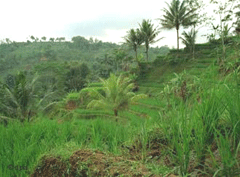
Indonesia is home to about ten percent of the world's rainforests. (Courtesy of Deutsche Welle)
CURWOOD: It’s Living on Earth. I’m Steve Curwood. One of the most controversial parts of the climate negotiations here in Bali, Indonesia, involved forests. Cutting forests, especially tropical forests, puts more CO2 into the air each year than all the cars and trucks combined on the whole planet. But so far the developing countries in South America, Africa, and Southeast Asia—that have the bulk of the world’s tropical forests—have gotten only limited support from the developed part of the world in the fight against deforestation.
The Bali talks call for more help and Indonesia will be one of the first in line. Indonesia recently planted over 11,000 acres of Sumatra, Kalimantan and Java with pines, acacia, and tropical hardwoods. But this island nation still has a long way to go with its long history of deforestation. Ging Ginanjar and Ari Bathara of Radio Deutsche Welle and Java’s Radio Bass FM prepared this report, which is presented by Michael Lawton.
[BIRDS CHIRP]
LAWTON: A roof of green leaves, the sound of trickling water, tall trees towering to the sky. Wildlife. That’s what people usually associate with forests. But if you’re looking for them in the teak forests on the island of Java, you could be very disappointed.
[SOUND OF LEAVES CRUNCHING]
LAWTON: We trekked through some of the teak forests on Java, from Bojonegoro in the east to Randublatung, Blora in the west. We started early in the morning, just before the first downpours, but a merciless sun was pounding on our backs, rivers of sweat were trickling down our faces. The only thing that remotely reminded us of the typical feel of a forest is the sound of dry teak leaves crunching under our feet, and perhaps the sound of birds chirping from afar. The teak trees here make up a somewhat unnatural forest. They’re planted in rows with regular spaces between them. Most of the trees are mere saplings. The diameter of the trunks is still around 30 centimeters. Bojonegoro was once known as ‘Teak City.’ It was surrounded by the vast teak forests of Java.
[ROOSTER CROWS]
LAWTON: Yanti (phonetic spelling), an elderly woman living in the village of Sumbergo (phonetic spelling) in the district of Margomulyo, is still able to tell her grandchildren about those days.
[YANTI SPEAKING INDONESIAN LANGUAGE]
VOICEOVER: It was very comfortable. There used to be mahogany trees on the left and teak trees to our right—big and tall ones. Monkeys were living in the forests back then, but nowadays there’s nothing left.
LAWTON: This teak forest was once one of the oldest and best-managed forests in Indonesia. But now there are many problems which threaten to destroy state teak forests in Java: overexploitation, forest fires, illegal logging and theft are just a few of them. There’s also corruption and mismanagement by the state forestry authorities. The political change which came with the downfall of President Suharto in 1998 proved to be disastrous for Java’s teak forests. People started cutting down teak trees and literally plundered the forests.

Indonesia is home to about ten percent of the world's rainforests. (Courtesy of Deutsche Welle)
[MAJIA SPEAKING INDONESIAN LANGUAGE]
VOICEOVER: It was crazy. People were no longer scared to go into the forest with trucks, cars, and even motorbikes.
LAWTON: Exhimaha Radana Majia (phonetic spelling), an environmental activist in Randublatung, tries to describe the damage done.
[MAJIA SPEAKING INDONESIAN LANGUAGE]
VOICEOVER: They took axes and saws with them. This was an expression of anger because most Indonesians never felt that the forests belonged to them. A lot of state forestry offices were burnt down.
LAWTON: Between 1998 and 2002, tens of thousands of hectares of woods were destroyed. Indonesian forest rangers had to stand by and watch helplessly. Sometimes they were even chased and beaten up by the people, says Robi (phonetic spelling), a forest ranger from Bojonegoro.
[MAN SPEAKING INDONESIAN LANGUAGE]
VOICEOVER: In those days they were after us, not the other way around. We were only two or three rangers and there were whole villages plundering the woods. At that time the scale of thefts was really unbelievable.
LAWTON: According to some figures, around 150,000 hectares of teak forest were destroyed by poor villagers following the political and social chaos in the post-Suharto era. But the plundering still continues, even if at a lower level. Krisdomo, head of the Forest Stakeholders Association in the region of Parangantuban (phonetic spelling), says that although vast areas of forest have been destroyed, it’s not benefited the local people. They still live in poverty.
[KRISDOMO SPEAKING INDONESIAN LANGUAGE]
VOICEOVER: These actions have not made any impact on the lives of the villagers who live near the forest. Their economic situation has not improved. Outsiders are still the ones who reap the money from the plundering. This is our main concern. We have to tackle both problems at the same time. On the one hand, we need to preserve our forests. But on the other hand, we want to help the people around here economically.
LAWTON: The forest destruction between 1998 and 2002 is a dark chapter in the history of the state forest company Perhutani, which is part of the Indonesian Forest Department. The Indonesian government amended the law on forest preservation in 1999. In 2002, based on this new law as well as past experiences, Perhutani designed a program called community-based forest preservation. This program tries to include locals in forest preservation measures. Villagers who live near the forests are encouraged to help keep the forests in tact. As a reward, they can use land surrounding the forests for their needs. They’re also entitled to 25 percent of the earnings from the forests’ produce. Community-based forest preservation might sound like a good idea at first, but the program has yet to who any evidence of success.
[SOUND OF BIRDS CHIRPING]
LAWTON: We went to visit one village, Randublatung, which has become infamous. It now has a nickname: Kampum Kaum Blandong (phonetic spelling), or ‘the village of the pillagers.’ Three people agreed to talk to us. All three of them are ‘blandong’ (phonetic spelling), or illegal loggers. One of them, Hairo (phonetic spelling), which is not his real name, says that government programs have never been introduced into his village.
[HAIRO SPEAKING INDONESIAN LANGUAGE]
VOICEOVER: We can be called thieves since we’re actually operating without having any permits from Perhutani. But we really are forced to do this. If we don’t know where to get money to buy food, we go into the forests.
LAWTON: But are the illegal loggers and the thieves the only ones to blame for the destruction of Java’s teak forest. Yuliani (phonetic spelling) an environmental activist in Bojonegoro, blames the sketchy and ambiguous measures which the government has tried to introduce to preserve the peak forests. A so-called master plan for East Java, states that the area of the plan is to be increased but no one knows how this is going to be implemented.
[YULIANI SPEAKING INDONESIAN LANGUAGE]
VOICEOVER: They say the forest is to be increased from 28 to 36 percent, but at the same time, there’s going to be more land for industry and housing. So, what are they going to sacrifice to plant more trees? Are they going to stop building houses or are they going to take away farmland? That’s not possible. And it’s even more unlikely that they just limit industry in favor of some trees.
LAWTON: Another problem, adds Yuliani, is the unclear definition of forest areas. Most of the two and half million hectares of the Perhutani land, which is characterized as forestland, has been cleared of trees entirely. Some patches are barren. Other parts are used as farmland. What’s left of the teak forest is a commercial forest, planted to be harvested, but not a conservation forest. Until the trees have grown enough to build a new, natural forest, the land is going to remain barren and unwelcoming.
[SOUND OF BIRDS CHIRPING]
LAWTON: The old Javanese forest only exists in fairy tales, the kind that Yanti tells to her grandchildren.
CURWOOD: Our report courtesy of Radio Deutshe Welle, and Java Radio Bass FM. It was reported by Ging Ginanjar and Ari Bathara and presented by Michael Lawton.
Related link:
Radio Deutsche Welle's "Living Planet"
Eco-Christmas Trees
CURWOOD: Thanks to this meeting here in Bali, and its focus on the importance of trees in the fight against global warming, we may develop more mechanisms to preserve and pay for the world’s great forests. But what about all those trees—some 35 million of them, that show up in people’s homes at this time of year: the Christmas trees. Most of them simply get tossed out come January. But before they land in the landfill, some folks are feeling better about where their evergreens come from. Trees grown sustainably, without chemical fertilizers and pesticides, greener greens if you will, are doing a brisk business these days. Living on Earth’s Alexandra Guttierrez brings this audio postcard from Harecrest Acres, a tree farm in Biddeford, Maine.
HAAS: Hello, my name is Matt Haas. You’re in Biddeford, Maine, and welcome to Harecrest Acres. And this is my little place in heaven. We’re going to go get ourselves a Christmas tree. So we’ll grab ourselves a saw. We’ve got a 25-acre farm here with about a thousand Christmas trees. We have a combination of Balsam Fir, Fraser fir, and Canaan Fir. They’re all native. And they all do fairly well on this soil type. And as you can see we do it with very little impact to the earth, so it looks a little rough but no chemicals are applied and it’s all just love and care.
[CHARLIE BROWN THEME SONG PLAYS, PEOPLE TALK, GIRL SAYS ‘I WANT THAT ONE’]
HAAS: Of course! Oh, that’s a good one all right. There’s a few Charlie Brown trees out here because everybody—every now and then somebody wants one.
GIRL: Do people really buy Charlie Brown Christmas trees?
HAAS: Occasionally they do, for—usually—relatives. (laughs) I give them a discount on a tree like this. That’s a one-year-old tree here. It’s only about eight inches. This one’s about a foot, and you can see by the third year once the roots get established then the tops start taking off and from there they grow quite rapidly. Who wants hot chocolate?
WOMAN: Nicky, you want some hot chocolate?
GIRL: Okay.
HAAS: Come on over!
WOMAN: You know you buy one from one of the big stores and you don’t know if it was cut down last month, and if we’re going to spend the money we would rather give it to the man down the road from us (laughs). It really was the best tree we ever had.
HAAS: I tell everybody to use their mittens. So you put your mittens on the one you think you want and then you keep looking, and then you go find another one that you like and when you run out of mittens you usually have to make a decision at that point.
GUTTIERREZ: I think this one might be the one. It looks just about the right size.
WOMAN: Oh I like it! That looks so pretty.
[SOUND OF SAWING]
GUTTIERREZ: So, there’s something satisfying about cutting down your own Christmas tree?
HAAS: Yeah, they even yell timber. It’s kind of fun.
MAN: YOU guys holding it?
HAAS: I got it yeah. Ready? Everybody yell.
EVERYONE: Timber!
WOMAN: Well done. Merry Christmas!
[MUSIC: Cyrus Chestnut “Linus And Lucy, Skating & O Tannenbaum” from ‘A Charlie Brown Christmas’ (Atlantic records 2000)]
CURWOOD: That audio snapshot of the Harecrest Acres treefarm in Maine was crafted by Alexandra Gutierrez.
Related link:
Harvest Acres
[MUSIC: Phil Aaberg and Bernie Krause, “Jungle Bells Fantasy” from ‘Wild Christmas’ (Miramar—1998)]
A Wild Xmas
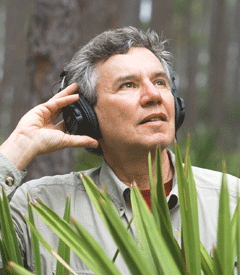
Bernie Krause (Photo: Tim Chapman)
CURWOOD: The tune’s familiar. But this is hardly the typical holiday Muzak that you can’t escape in the neighborhood mall. No. Nature herself provided the raw material for these holiday standards. They were compiled as a ‘Wild Christmas’ back in 1991 by Phil Aaberg and Bernie Krause. The album has long been out of print but is now being re-issued, only for download on the web.
KRAUSE: This album really consists of just animal sounds. There are no synthesizers, no traditional instruments. And we managed to put this together by going through this large archive of material that I have and finding ones that kind of fit the voices of more traditional music instruments.
[SQUEAKING TO THE TUNE OF ‘DECK THE HALLS’]
KRAUSE: The intro is made of dolphins.
[SQUAKING OF ‘FA LA LA LA LA LA LA’]
KRAUSE: And of course the ‘la las’ are a parrot: Molly the parrot.
[THUMPING NOISE]
KRAUSE: And you have the baby mountain gorilla that was recorded in the late Diane Fossey’s camp at Karisoke in Rwanda.
[GROWLING AND SNAPPING SOUNDS]
KRAUSE: And you have the snapping fish tapping on the music stand saying ‘come on guys, let’s get it together.’ We would take a parrot or a walrus and we’d sample the sound. We’d do a small recording, a short recording of each of those voices, and then we’d put it into a midi synthesizer, establish a range of frequency around it—like, maybe two octaves for the walrus or an octave for the parrot—and give it an octave range. And then we would just play it like we play a normal instrument.

Bernie Krause (Credit: Tim Chapman)
[CHRIPING AND BUZZING]
KRAUSE: One of the neat things about ‘Amazing Grace’ is that it begins with sounds that are recorded in the Amazon at a place called Kilometer 41, which is a research station north of Minais, which is kind of midway in the Amazon.
[DEEP BLOWING SOUND AND CHIRPING]
KRAUSE: And there’s also a bird there called the Common Potoo. And a common Potoo is a melodic bird that does kind of a bluesy sound and has a bluesy melody. And so we wanted to include that as kind of a reference point mixed in with all the other animals that you hear in that soundscape.
[COMMON POTOO SINGS MELODY OF ‘AMAZING GRACE’]
KRAUSE: The key is always to find a way to bring out the Western musicality in these animals. And it’s surprising how many animals do have this musical quality.
When we were recording in places like the Amazon or Africa, what we found was that these animals all voiced together, all sing together, in relationship to one another—much like instruments in an orchestra. And one of the ways we wanted to bring this to people’s attention was through albums like ‘A Wild Christmas,’ where we actually take the animals and group them together in traditional musical form, so that people can actually hear them singing together.
[‘WE WISH YOU A MERRY CHRISTMAS’ PLAYS]
CURWOOD: Bernie Krause sampled the natural world for “A Wild Christmas.’ Living on Earth’s Eileen Bolinsky produced our tribute. You can find the music online at www.wildsanctuary.com.
Related link:
"A Wild Christmas" - WildSanctuary.com
[INDONESIAN MUSIC PLAYS]
CURWOOD: At an open-air stage along the beach at Tanjoe in Bali, dancers twirl and spread their fingers to tell the age-old story of stealing a lover as a gamelon orchestra provides the metallic tones and rhythms.
[GAMELON ORCHESTRA PLAYS]
CURWOOD: Living on Earth is produced by the World Media Foundation. Our crew includes Ashley Ahearn, Bobby Bascomb, Eileen Bolinsky, Bruce Gellerman, Ingrid Lobet, Helen Palmer, Emily Taylor, and Jeff Young. Our interns are Alexandra Gutierrez and Mitra Taj. Jeff Turton is our technical director. Alison Lirish Dean composed our themes. You can find us at LOE dot org. I’m Steve Curwood, reporting from Nusa Dua, Bali, Indonesia. Thanks for listening.
ANNOUNCER: Funding for Living on Earth comes from the National Science Foundation, supporting coverage of emerging science. And Stonyfield Farm: organic yogurt and smoothies. Stonyfield pays its farmers not to use artificial growth hormones on their cows. Details at Stonyfield.com. Support also comes from you our listeners, the Ford Foundation, the Town Creek Foundation, the Oak Foundation, supporting coverage of climate change and marine issues, and Pax World Mutual Funds, socially and environmentally sustainable investing. Pax World: for tomorrow. On the Web at PaxWorld.com.
ANNOUNCER 2: PRI: Public Radio International.
Living on Earth wants to hear from you!
Living on Earth
62 Calef Highway, Suite 212
Lee, NH 03861
Telephone: 617-287-4121
E-mail: comments@loe.org
Newsletter [Click here]
Donate to Living on Earth!
Living on Earth is an independent media program and relies entirely on contributions from listeners and institutions supporting public service. Please donate now to preserve an independent environmental voice.
NewsletterLiving on Earth offers a weekly delivery of the show's rundown to your mailbox. Sign up for our newsletter today!
 Sailors For The Sea: Be the change you want to sea.
Sailors For The Sea: Be the change you want to sea.
 The Grantham Foundation for the Protection of the Environment: Committed to protecting and improving the health of the global environment.
The Grantham Foundation for the Protection of the Environment: Committed to protecting and improving the health of the global environment.
 Contribute to Living on Earth and receive, as our gift to you, an archival print of one of Mark Seth Lender's extraordinary wildlife photographs. Follow the link to see Mark's current collection of photographs.
Contribute to Living on Earth and receive, as our gift to you, an archival print of one of Mark Seth Lender's extraordinary wildlife photographs. Follow the link to see Mark's current collection of photographs.
 Buy a signed copy of Mark Seth Lender's book Smeagull the Seagull & support Living on Earth
Buy a signed copy of Mark Seth Lender's book Smeagull the Seagull & support Living on Earth

